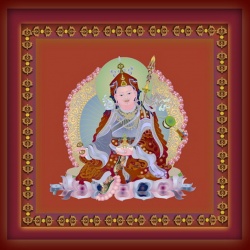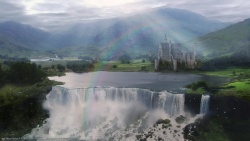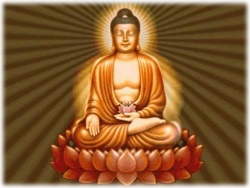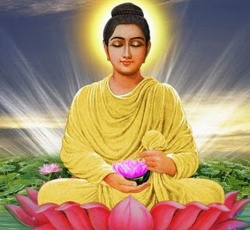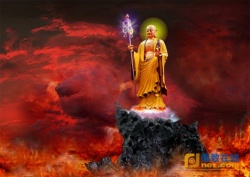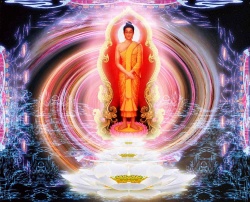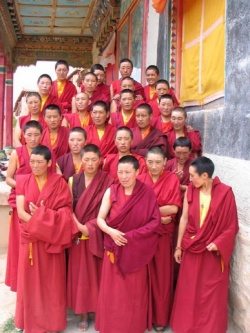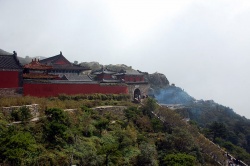Understanding The Three Dharma Seals
In Buddhism you are bound to hear that you should “see the world as it truly is” (or similar).
But what does it mean? Are your glasses dirty? Is this some weird Matrix movie reference?
The Three Dharma Seals
Over 2,600 years ago, the Buddha taught mankind what the world was like through his teachings of the Dharma.
Specifically, the Four Noble Truths explained why there is suffering in our lives, and how to eliminate it.
As the Buddha explained, attachment to conditioned phenomena leads to suffering.
Since then, Buddhists have used what they call the “Three Dharma Seals” to verify a Buddhist teaching is authentic.
These seals are “stamped” onto everything in our world without exception, and at all times.
They are:
All Conditioned Phenomena Are Impermanent (Anicca)
All Conditioned Phenomena Are Without an Independent Self (Anatta)
Nirvana is Perfect Tranquility
“Conditioned Phenomena” refers to phenomena such as sensations, perceptions, thoughts, impulses, things, “you”, humans, animals, plants, bacteria, countries, politics, countries, etc.
They are ‘conditioned’ because they arise (and end) from causes and conditions which are subject to change.
Everything in our world is marked with these characteristics, but we often don’t see or want to acknowledge it.
(note: if you’ve been reading Buddhist writings and are wondering why “Dukkha”, aka: “Suffering”, is not included, you’ll find the answer in the last part of this article)
Seal 1
We really want things to be permanent in our life. Heck, even singer Marvin Gaye wrote an entire song about it! But life isn’t like that.
The Buddha taught that all conditioned things are impermanent and change (“Impermanence”).
In the physical form, we know that we are born, grow, get sick, and eventually die. Our world was born and will eventually die.
The seasons come and go and come back again. Your thoughts come and go.
Everything changes. What you think is permanent, is not, which is often a very hard truth to come to terms with especially when it comes to people and things we love deeply and are attached to. As Ven. Thich Nhat Hanh explains it:
If you suffer, it is not because things are impermanent. It is because you believe things are permanent. when a flower dies, you don’t suffer much, because you understand that flowers are impermanent. But you cannot accept the impermanence of your beloved one, and you suffer deeply when she passes away.
On the surface, impermanence sounds like a lot of Dukkha (suffering)!
After all, what a dreary place life must be where everyone dies, things are destroyed, etc.
But in-fact, impermanence teaches us value in our lives.
For example I didn’t fully want to understand impermanence many years ago, and in a short amount of time my mother got sick and died.
If I understood impermanence, I would have cherished to an even greater degree our relationship. As Ven. Master Hsing Yun explains:
Properly understood, the concept of impermanence can be a great aid in difficult situations.
If we are poor, impermanence can teach us that our circumstances will not last forever.
If we meet with a setback in our work, it can teach us not to despair.
If we meet with hardship or tragedy, impermanence can teach us that one day, things will change again for the better.
Impermanence tells us that nothing stays the same; it teaches us that things can change for the better if we truly work to better our circumstances.
Understanding impermanence allows us to change suffering into joy. We know that bad things can change to good, and allows us to understand we need to cherish and love in the present moment.
Seal 2
The second seal states that nothing is independent (“Nonself”). Compared to other religions of the world where “you” are permanent, Buddhism says the opposite. Sentient beings (such as people) don’t have an independent self that is unchanging.
Physically you can see your body change, but even “you” change as you are interconnected with everything around you.
Because we are very much attached to the concept of “me”, it’s hard to grasp this concept also.
The Buddha said that “you” is temporary caused by the combination of physical and mental components of existence.
When conditions bring these two components together, your body is formed.
And when conditions cease, your body will also cease. There is nothing permanent in you.
A note of caution, this doesn’t mean “you” are not here and don’t exist!
Ven. Master Hsing Yun explains why this is an important concept to understand:
The reason Buddhists emphasize the lack of an independent self is to help each one of us get past the narcissistic devotion we normally feel toward our body and the deluded belief that the body “proves” that there is some absolute “self”.
Attachment to the self is the root source of all delusion. It produces anger and greed, and keeps us bound firmly to ignorance.
Contemplation of the second Dharma seal will teach us how to break the bonds of self-love.
By understanding nonself, as Ven. Master Hsing Yun explains, we can remove deep-seated and painful feelings that arise from the erroneous belief that we possess a permanent self that really can be threatened, or insulted, or defamed.
Seal 3
The third seal, Nirvana, reveals that all conditioned phenomena are actually tranquil and without suffering. ‘Suffering’ is caused by delusion, and that delusion is believing that things will always be this way (permanent) and separate (independent), which is not the case as explained in the first two seals.
Nirvana cannot exist seperate of impermanence and nonself.
Nirvana is the state (or ‘refuge’) in which you experience perfect tranquility in the here and now. Greed, anger, ignorance, arrogance suffering, delusion, and doubt are eliminated.
When you put away those rose colored glasses and see the world as it truly is, you can enter the state of Nirvana and not let the suffering caused by these conditions affect you anymore.
Even if you don’t achieve Nirvana, understanding and coming to terms with these concepts helps you ‘make those rose colored glasses’ more clear.
This way, you can experience and handle life in a new way that benefits you and others.
Ven. Master Hsing Yun explains:
Life is like a turbulent ocean, with crashing waves coming one after another.
The continuous movement of the ocean exemplifies the impermanence of all phenomena.
But if we can look at the waves through the eyes of the Buddhist sages, we can see that although the waves are turbulent, the nature of water is to be calm.
Likewise, life is an endless cycle of birth and death, but our intrinsic nature is a state of perfect peace.
Thus, if we want to attain the liberation and tranquility of nirvana, we must realize it in the impermanence and nonself of all phenomena.
In other words, understanding that both things change (impermanence) and that everything is connected (nonself), you can achieve your nature state which is the peace of nirvana.
Different Suffering (Dukkha) for Different Folks
This next part will only be of interest for those who are wondering “why isn’t Dukkha (aka “suffering” or “dissatisfaction”), part of the Three Seals you have up there?”.
After all, you’ve probably seen it many times on the internet listed as part of the three seals.¹
In the Southern transmission school (Theravada), “Dukkha” (which has a variety of meanings such as suffering, dissatisfaction, etc.) is added to the above to form their Three Dharma Seals (it is added right between #1 and #2 above).
However this is not completely accurate because it is actually the Three Marks of Existence (in the Pali commentary tradition) and not the Three Dharma Seals.
Theravada Buddhism understands the seals this way because early in this school’s early history suffering (Dukkha) was part of everything in life according to their interpretation of the Buddha’s teachings (namely, through the theory of the Three Kinds of Suffering).
Because both the Three Dharma Seals and Three Marks of Existence have “Impermanence” and “Non-Self” in them, they are often confused with each other, but both have different purposes.
This misunderstanding is unfortunately commonplace due to early translation and transmission of scripture.
Mahayana looks at the Three Dharma Seals based on many sutras such as the Samyukta Agama (Sutra 293), Master Zhiyi’s commentary on the Lotus Sutra, and also the Nagarjuna Sutra where the Buddha taught impermanence, nonself, and nirvana as the seals.
This is because Dukkha is not present in all things, and it is in-fact created as a result of Anicca (impermanence) and Anatta (non-self).
For example, if we use the example of waves on the ocean…that’s not the true nature of the water, which is to be still instead of having waves.
We use Anicca and Anatta to create Dukkha in our lives, but Dukkha is not always in our lives or in things.
Nirvana, however, is always there because it is our true nature not to have Dukkha.
Teachers such as Ven. Master Hsing Yun, Ven. Thich Nhat Hanh, and many others follow this version of the seals.
Dukkha isn’t “eliminated” from the Mahayana view, because Dukkha is always the first part of the Four Noble Truths, which is part of all Buddhist traditions teachings.
Ven. Master Hsing Yung explained:
…nirvana is not something attained apart from all other phenomena. All phenomena are originally nirvana.
Ven. Thich Nhat Hanh explained that adding “suffering” to the Dharma seals doesn’t help with understanding the true nature of things:
It is said that all teachings of the Buddha bear the Three Dharma Seals.
To put suffering on the same level as impermanence and nonself is an error. Impermanence and nonself are “universal.” They are a “mark” of all things. Suffering is not.
It is not difficult to see that a table is impermanent and does not have a separate self of all non-table elements, like wood, rain, sun, furniture maker, and so on.
But is it suffering? A table will only make us suffer if we attribute permanence or separateness to it.
When we are attached to a certain table, it is not the table that causes us to suffer. It is our attachment.
We can agree that anger is impermanent, without a separate self and filled with suffering, but it is strange to talk about a table or a flower as being filled with suffering.
The Buddha taught impermanence and nonself to help us not be caught in signs.
While this may seem strange for those who understand Dukkha to be in their version of the Three Dharma Seals, he explains it this way:
But suffering is not a basic element of existence.
It is a feeling. When we insist on something that is impermanent and without self being permanent and having a self, we suffer.
The Buddha taught that when suffering is present, we have to identify it and take the necessary steps to transform it. He did not teach that suffering is always present.
That being said, you will see different Mahayana schools either take the Theravada viewpoint of the Three Seals, or include Dukkha as the fourth seal.
I prefer the above approach, but it boils down to what is best for you to understand and apply to your practice.
I agree with Ven. Thich Nhat Hanh when he said:
To me, it is much easier to envision a state where there are no obstacles created by concepts than to see all things as suffering.
I hope scholars and practitioners will begin to accept the teaching that all things are marked by impermanence, nonself, and nirvana, and not make too great an effort to prove that everything is suffering.
Further Reading & References
You can learn more about the Three Dharma Seals in the books “The Core Teachings: Essays in Basic Buddhism” by Ven. Master Hsing Yun, and “The Heart of the Buddha’s Teachings” (Refer to chapters 4, 5, and 18) by Ven. Thich Nhat Hanh.
¹ Thanks to John Gill (the English language editor at Buddha’s Light Publishing) who helped with some of the background about why Dukkha is not always part of the Three Dharma Seals.
